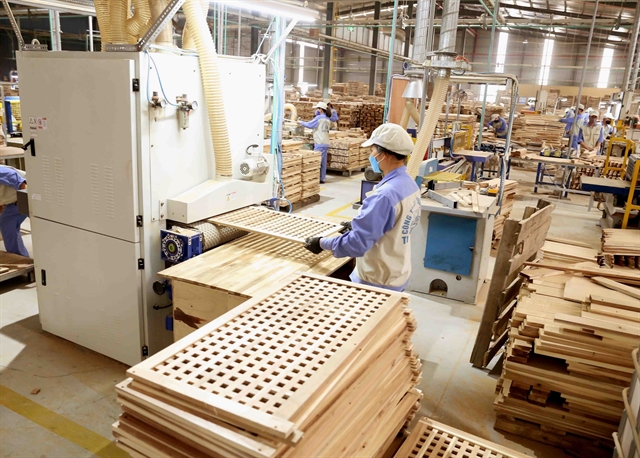 Economy
Economy


|
| Producing wooden furniture for export to the EU market at WOODSLAND Tuyên Quang JSC. — VNA/VNS Photo |
HÀ NỘI — With a growth rate of over 20 per cent and positive signs of recovery from the market, wood and timber exports are forecast to grow positively in the last months of 2024.
“The export market for timber and wood products is seeing positive recovery signals, particularly in the main export products, including wood chips, which have increased by nearly 38 per cent, and timber and wood products, which have risen by over 20 per cent year-on-year,” Director of the Forestry Department under the Ministry of Agriculture and Rural Development, Trần Quang Bảo, said.
He added as a result, over the past seven months, the export value of wood and forestry products is estimated to have reached US$9.36 billion, up 20.5 per cent compared to the same period in 2023. Of the total, timber and wood products alone account for $8.75 billion. The US market increased by 24 per cent.
Việt Nam's wood and forestry sector aims to export $15.2 billion worth of its products this year, an increase from $14.47 billion last year.
However, experts believe that to achieve this target, the wood industry will face many obstacles, which the industry’s business community will need concerted efforts to overcome.
Since the slowdown in 2023, from the beginning of this year, wood and forestry processing associations and enterprises have been proactive in production and seeking export markets.
A series of market exploration fairs were held, attracting customers’ interest in Vietnamese wood products in key production areas, including HCM City, and Bình Định and Bình Dương provinces.
Bảo emphasised that the global economy in 2024 is still under pressure from high interest rates, trade tensions, military conflicts and political instability. This could affect the demand for wood and wood products in the final months of the year. Việt Nam's main wood export markets, including the EU, the US, Japan and South Korea, are facing economic difficulties and protectionist measures.
"In the US market, the investigation into anti-circumvention duties on wooden cabinets and dressing tables from Việt Nam has concluded. However, in the future, the US will increase control and post-clearance audits on these items. At the same time, the US will continue to support domestic enterprises by increasing trade defence measures through anti-dumping and anti-subsidy investigations," he said.
Regarding the South Korean market, the Korea Trade Commission recently concluded its investigation and decided to continue applying anti-dumping tax. As a result, Vietnamese plywood manufacturers and exporters will continue to be subject to this tax for the next five years, with rates ranging from 9.78 to 32.28 per cent.
In the EU, the European Union Deforestation Regulation (EUDR) will come into effect in December 2024.
Lê Minh Thiện, chairman of the Bình Định Timber and Forest Products Association, said if wood industry businesses comply well with this regulation, it will enhance their competitiveness in the EU and the penetration of wood products into this market will increase significantly.
However, if companies fail to meet the EUDR requirements, their goods will face difficulty entering the EU market, which will exclude them from the global supply chain.
Regarding solutions for the Vietnamese wood industry, Chairman of the Việt Nam Timber and Forest Products Association Đỗ Xuân Lập said that businesses need to focus on improving competitiveness based on five main pillars. It includes improving production techniques and using technology, emission reduction, trade promotion, and building internal monitoring standards.
Chairman of the Bình Dương Wood Processing Association (BIFA) Nguyễn Liêm assessed that the recent strong growth in wood and wood product exports is a positive outcome for Việt Nam's wood industry, amid many difficulties.
“However, to grow and develop sustainably, wood industry enterprises need to proactively adapt to all conditions and circumstances, thereby making flexible changes in production, business and export processes. The development of technology and the supply chain for products, from raw materials to logistics, is critical,” he added. — VNS




